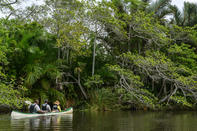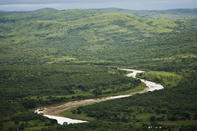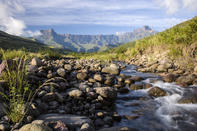Lubombo Transfrontier Conservation and Resource Area
This one is more of a Russian egg than any other superpark. It encompasses five distinct Transfrontier Conservation Areas (TFCAs) in South Africa, Mozambique and Swaziland, namely Lubombo Conservancy-Goba (Mozambique and Swaziland); Usuthu-Tembe-Futi (Swaziland, South Africa and Mozambique); Ponta do Ouro-Kosi Bay (Mozambique and South Africa); Nsubane-Pongola (South Africa and Swaziland); and Songimvelo-Malolotja (South Africa and Swaziland).

The conservation and resource area includes the existing iSimangaliso World Heritage Site as well as five Ramsar sites (international bird migration hotspots): Ndumo Game Reserve, Kosi Bay, Lake Sibaya, Tongaland and Lake St Lucia, which at 350 km is the largest estuary in Africa. According to the Peace Parks Foundation this is one of the most striking areas of biodiversity in the world; talk about a super-duper park!
Mfolozi River

Just like the Hluhluwe-iMfolozi Park is two game reserves in one (named after the two rivers), so the Mfolozi River is two rivers in one. Both the White and Black Mfolozi rise in the heart of the Zululand Battlefields, east of Ncome River and either side of Hlobane Mountain.
They, more than any other physical feature, have played a central role on the history of the Zulu people, as far back as records show. From where they converge in the iMfolozi section of the park, it's a relatively short flow to the sea - past Mtubatuba, into the Maphelane Section of iSimangaliso Wetland Park and out into the Indian Ocean at St Lucia.
uThukela River

After creating those glorious falls, hurtling some 948 m over the escarpment and cutting its way through the soft sandstone of the Tugela Gorge, the uThukela River races through braided channels in the Royal Natal Park and then spews out into two dams, before really getting on with its business of being the principal waterway of KwaZuIu-Natal.
uThukela comes from the Zulu verb tuku, to startle or astonish, but in the sense of the river's name it means 'the fearsome one'. Indeed, when summer storms in the mountains feed its fury, it becomes not only a life-giving but a life-taking force.
It is the people of Gauteng who have most to thank the river for, because when their Vaal starts to run dry - as it does every so often - water from the uThukela is pumped via various dams, all the way to the Highveld, to add pure mountain water to the Vaal.